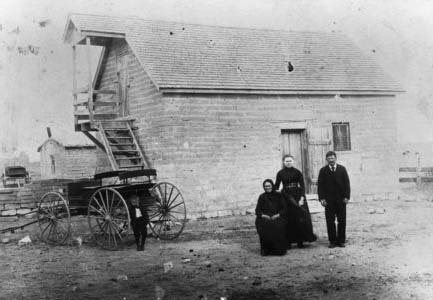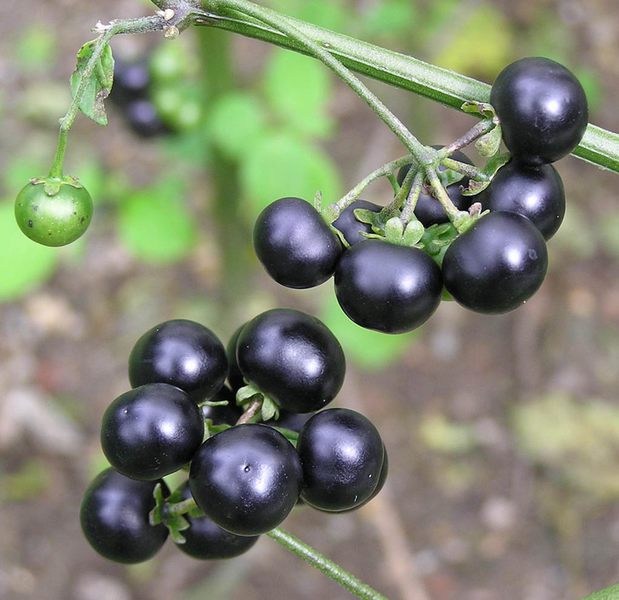| Reprinted from this page by Sam Brunghardt
About Schwartzberren
Schwartzbeeren (literally "black berries"), are a type of edible black nightshade (Solanum nigrum) that was grown in many of the Volga German colonies.
I was reared in Ellis County, Kansas, and the Volga Germans who
settled there brought seed of Schwartzbeeren along to the United
States when they emigrated, beginning in the 1870s. Today, many of
those settlers' descendants (including my mother) grow Schwartzbeeren
to use in traditional preparations, including Kuchen and Maultaschen.
They are also served with Klump or Knebel (dumplings). More modern
methods of preparation incliude pie and coffeecake. Schwartzbeeren
are not the same species as what is often called "Garden Huckleberry"
in the United States. Unlike Garden Huckleberry, which benefits from
a very long growing season (they are generally picked just before
frost), Schwartzbeeren may be eaten as soon as their skin turns from
shiny to dull and from green to dark, puplish black. Although the
flavor is fairly acidic, it is sweet when the berries are dead ripe,
and beloved by many who grew up eating them.
|
|
|
There are a number of recipes that feature Schwartzbeeren in the Sei Unser Gast (Be Our Guest) Volga German cookbook, published by the North Star Chapter of Minnesota, AHSGR (to order the cookbook go to http://www.ahsgr.org/mnnostar.html ).--Sam Brungardt, St. Paul, Minnesota.
Traditionally, Schwartzbeeren were grown as a volunteer crop. They were never intentionally planted. Instead, seedlings came up “volunteer” once the soil had been warmed in the spring from seed that had been produced and dropped to the ground the summer before. The gardener then spaced the Schwartzbeeren plants by hoeing out or pulling up the excess seedlings. |
 |
Schwartzbeeren plants grow 2 to 3 feet tall, depending on how far apart they are spaced, hoe much water they receive during the growing season, and the fertility of the soil. Since volunteer Schwartzberren come up in the garden at about the same time as volunteer tomatoes, one can conclude that conditions that are conducive for good germination of tomato seeds are the same ones that Schwartzberren seeds require – a soil temperature of 970 to 90 degrees F.
Sow the seed indoors a month to six weeks before the frost=free date for your area. It will take 6 to 14 days for the seedlings to emerge. After the seedlings are large enough to handle (about the time they have their first true leaves), transplant them to small pots. Or simply sow the seed in a sunny place in the garden a couple of weeks before the frost-free date for your area, covering it with 1/8 to ¼ inch of soil. You may be able to identify the seedlings by the holes that sometimes develop in the leaves.
Thin or transplant the seedlings to stand 2 to 3 feet apart. Schwartzbeeren berries are about ¼ inch in diameter and are produced in clusters of 5 to 10. They consist of a thin, purple-black skin filled with juice and many small seeds. Schwartzberren are fully ripe when the skins of the berries have turned from green to dark purplish-black.
They consist of a thin, purple-black skin filled with juice and many small
seeds. Schwartzberren are fully ripe when the skins of the berries have turned from green to dark purplish-black and have lost their sheen. If the berries are picked before they are dead ripe, they will not be as sweet as they could be and they will have unattractive, green juice.
The flavor of Schwartzbeeren is rather difficult to describe; the berries are sweet with a somewhat acidic flavor.
To pick Schwartzbeeren , “tickle” them from their clusters, do not pinch or squeeze the berries or they will burst. The Volga Germans enjoyed Schwartzbeeren in several ways. They used the berries, mixed with sugar and flour and perhaps an egg and cream for a topping for Schwartzbeerenkuchen.
They also used the berries, mixed with sugar and flour, to fill Maultaschen, a filled pasta similar to pirogi or vereniki. And sweetened Swartzbeeren were sometimes put over dumplings that have slathered with Schmeltz (a rich butter and cream sauce). Volga Germans who immigrated to North America also learned to use berries for pie, coffeecake and jam. Recipes using Schwartzbeeren can be found in the Sei unser gast (Be our guest)
cookbook sold by the North Star VChapter of Minnesota of the American Historical Society of Germans from Russia. Go to
http://www.northstarchapter.org/ on the internet or write to Cookbook
Orders, North Star Chapter of Minnesota, PO Box 583642, Mineapolis, MN 55458-3642.
Adapted from this cookbook
Sei Unser Gast and Karen Bursaw
This is a specialty from Volga Germans who that
settled in Texas. |
| |
|
|
|
|
Looking for another recipe?
Enter your recipe request and search
|
Where to shop for German Foods and Things

I order from the German Deli more frequently than ever.
I try to get in bulk to make the shipping dollars count.
Also there are sales all the time I like to take advantage of.
They are nice folks. If you don't believe me call them.
and tell them Stephen Block sent you from the German Goodies Newsletter.
Shop for German Food

Go here and search for all kinds of German Food |
|

Do you have a question or comment on this recipe?
make sure you put the recipe name in the subject line
Listen to German Music
Listen to the Chicken Dance, and download it
CD's recommendations and links
Do you have a German Name?
Also what your German name means
Do you want to learn to speak a little German?
Learn one word a day.
Explore your German Heritage
Find out if your relatives came over through Ellis Island and more good links
|









